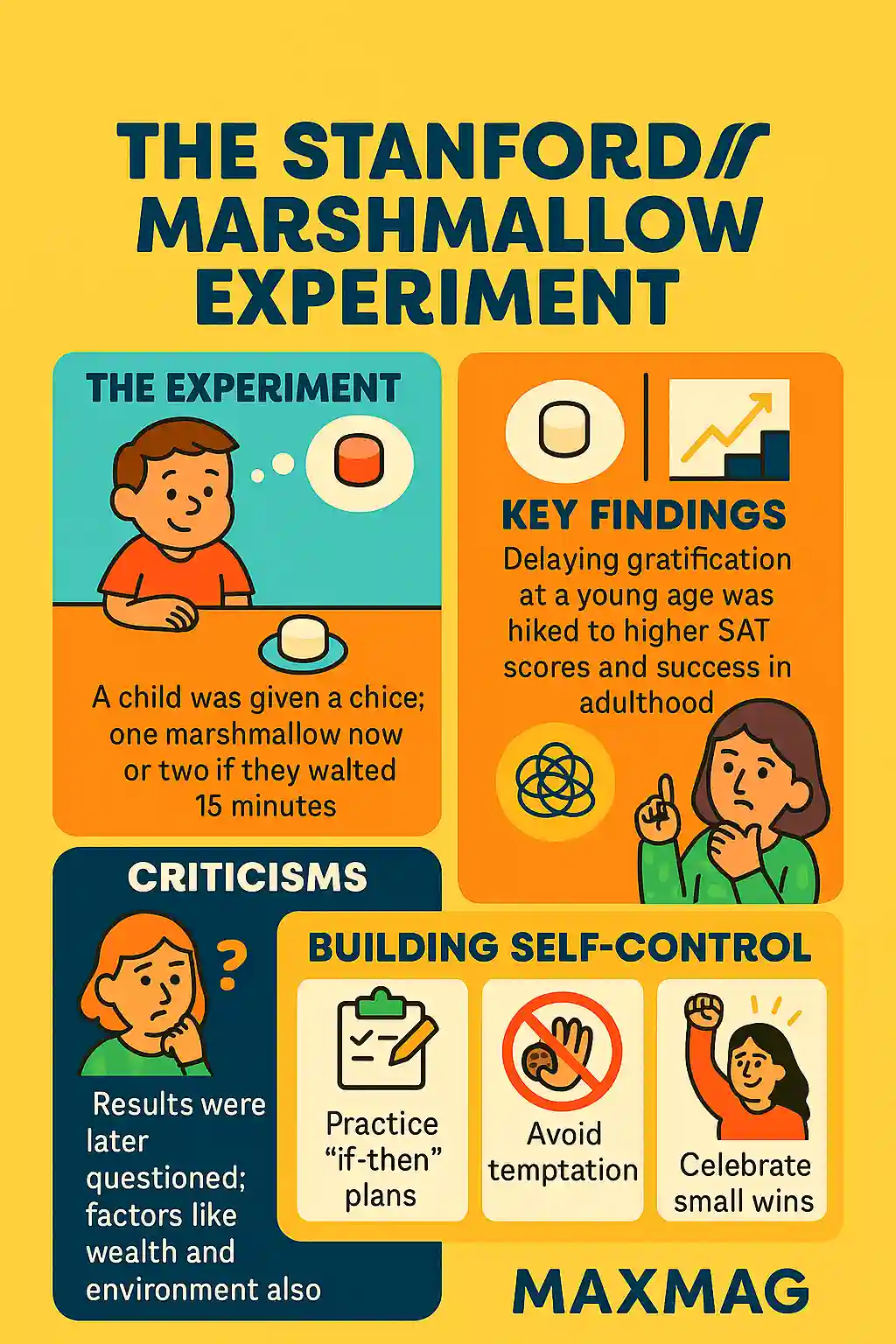
In the early 1960s, psychologists set up a deceptively simple test to explore willpower. A child was offered one marshmallow now or two marshmallows if they waited 15 minutes. It became legendary as the Stanford marshmallow experiment—a vivid demonstration of how self-control influences long-term outcomes. Over time, researchers found that the ability to delay gratification at age four or five often predicts better health, stronger academic performance, and more stable relationships in adulthood.
This article delves into the heart of the Stanford marshmallow experiment: how it was designed, what we’ve learned from it, why it still matters, and how you can strengthen your own willpower.
1. What Was the Stanford Marshmallow Experiment?
Stanford researcher Walter Mischel and his team invited preschoolers into a room with a table and one marshmallow. They explained: “You can eat it now, or wait 15 minutes and get two.” Then the adult left. The child had to manage the temptation alone.
This simple setup revealed powerful insights. Some kids could wait; others gave in quickly. Follow-up studies showed those who waited longer often had higher SAT scores, better stress coping mechanisms, and lower body mass index (BMI) years later.
The Stanford marshmallow experiment became a symbol of delayed gratification—and its connection to future success.
2. Key Results Over Time
Early findings from the Stanford marshmallow experiment suggested that children who resisted temptation performed better later in life. But researchers cautioned that self-control isn’t destiny—it interacts with environment and resources.
A 2018 follow-up study found that external factors—like family wealth—played a huge role in whether kids waited. For children from disadvantaged homes, immediate reward sometimes made practical sense. The takeaway? Teaching self-control matters—but so does building trustworthy environments.
3. Understanding Self–Control and the Brain
The Stanford marshmallow experiment highlights the power of self-control. It’s the discipline to pause a desire now to gain something greater later. Neuroscientists note that self-control involves balancing the impulsive brain (the limbic system) with the rational frontal cortex. Strengthening this balance improves emotional regulation, decision-making, and resilience.
Behavioral psychologists encourage exercises like mental rehearsals, breathing techniques, and “if–then” planning (“If I feel the urge, I’ll take three deep breaths”). These tools help manage impulses and build stronger habits over time.
4. Real-World Influence in Education and Business
Educators have adapted the Stanford marshmallow experiment to help students develop grit and attention. Schools use games, delayed rewards, and structured routines to train patience. In business, this translates to long-term planning, delayed sales gratification, and resisting short-term temptations that hamper growth.
Authors like Angela Duckworth, who wrote Grit, build on the marshmallow study and show that perseverance is as critical as self-control for success.
5. Criticisms and Modern Reinterpretations
As the Stanford marshmallow experiment has aged, critics have pointed out limitations:
-
Socioeconomic bias: Wealthier families reacted differently in the test, calling into question the fairness of generalizing results.
-
Replication challenges: Some studies failed to reproduce strong correlations.
-
Parental role: Children with secure attachments were more likely to wait—and this may reflect emotional security rather than pure self-control.
Despite these critiques, most researchers agree: self-control is valuable—especially when supported by stable, supportive environments.
6. How to Strengthen Your Self–Control
Based on insights from the Stanford marshmallow experiment, here are effective, practical strategies:
-
Create “If–Then” Plans
Example: “If I feel tempted, I’ll walk away for five minutes.” -
Use Visual Cues
Removing temptations or replacing them with healthy options reduces temptation. -
Practice Mindfulness
Seven to ten minutes of daily meditation can improve self-awareness and impulse control. -
Break Big Goals into Steps
Delayed rewards feel more achievable when progress is visible. -
Celebrate Small Wins
Reinforce positive habits with praise, not treats or distractions.
The Stanford marshmallow experiment proved that small, consistent efforts can strengthen your willpower reservoir.
7. Why It Still Matters Today
In an era of instant gratification—from binge-watching to fast food—the Stanford marshmallow experiment remains relevant. It reminds us: impulses can be managed and choices shape our future.
Global issues like climate change, financial planning, and health rely on collective self-control. Each decision, small or large, echoes the marshmallow test: pause now to benefit later.
Frequently Asked Questions
Q1: What exactly was the Stanford marshmallow experiment?
It tested whether preschoolers could resist eating a marshmallow now for the promise of two later—measuring immediate self-control and its predictive value.
Q2: Did the kids who waited really do better later?
Yes—but with nuance. Early studies linked waiting with better outcomes, though newer research highlights environmental factors like stability and trust.
Q3: Can adults benefit from marshmallow strategies?
Absolutely. Techniques like “if–then” planning and mindfulness are age-neutral ways to boost self-control.
Q4: Is self-control innate or learned?
Both. Some people have a naturally stronger impulse filter, but training, environment, and habits play a crucial role.
Q5: How long does it take to improve self-control?
Daily practice—over weeks or months—yields noticeable benefits. Like any skill, consistency matters more than speed.





